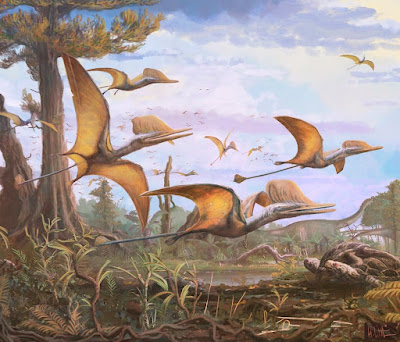 |
| Ceoptera evansae Martin-Silverstone, Unwin, Cuff, Brown, Allington-Jones & Barrett, 2024 |
ABSTRACT
The Middle Jurassic was a critical time in pterosaur evolution, witnessing the appearance of major morphological innovations that underpinned successive radiations by rhamphorhynchids, basally branching monofenestratans, and pterodactyloids. Frustratingly, this interval is particularly sparsely sampled, with a record consisting almost exclusively of isolated fragmentary remains. Here, we describe new material from the Bathonian-aged Kilmaluag Formation of Skye, Scotland, which helps close this gap. Ceoptera evansae (gen. et sp. nov.) is based on a three-dimensionally preserved partial skeleton, which represents one of the only associated Middle Jurassic pterosaurs. Ceoptera is among the first pterosaurs to be fully digitally prepared, and µCT scanning reveals multiple elements of the skeleton that remain fully embedded within the matrix and otherwise inaccessible. It is diagnosed by unique features of the pectoral and pelvic girdle. The inclusion of this new Middle Jurassic pterosaur in a novel phylogenetic analysis of pterosaur interrelationships provides additional support for the existence of the controversial clade Darwinoptera, adding to our knowledge of pterosaur diversity and evolution.
SYSTEMATIC PALEONTOLOGY
PTEROSAURIA Kaup, 1834
MONOFENESTRATA Lü, Unwin, Jin, Liu, Ji, 2010
DARWINOPTERA Andres, Clark, Xu, 2014
Ceoptera evansae, gen. et sp. nov.
Diagnosis—Ceoptera is distinguished from all other pterosaurs by two features: (1) the presence on the distal (sternal) portion of the coracoid shaft of a well-developed, elongate, narrow, sub-rectangular bony flange (probably a site for insertion of the m. sternocoracoideus) with an irregular ‘wavy’ free margin, which extends proximally for almost one-quarter of the length of the coracoid; and (2) the lateral surface of the posterior, dorsally expanded, portion of the post-acetabular process of the ilium bears a prominent depression divided in two by a low rounded vertical ridge.
Type Locality and Horizon—Cladach a’Ghlinne, north of Elgol, Isle of Skye, Scotland, U.K.; Kilmaluag Formation (Bathonian, Middle Jurassic) (Barrett, 2006; Evans et al., 2006; Panciroli et al., 2020).
Etymology—The generic name is composed of the Scottish Gaelic word cheò or ceò (pronounced ‘ki-yo’), meaning mist (in reference to the common Gaelic name for the Isle of Skye Eilean a’ Cheò, or Isle of Mist), and the Latin ptera, meaning wing (feminine). The specific epithet honors Prof. Susan E. Evans for her many years of anatomical and paleontological research, in particular on Skye, and in introducing us to this locality, thereby making this find possible.
 |
| Ceoptera evansae is the first species of darwinopteran pterosaur found in Scotland, and only the second overall. Image © The Trustees of the Natural History Museum, London/Mark Witton |
Elizabeth Martin-Silverstone, David M. Unwin, Andrew R. Cuff, Emily E. Brown, Lu Allington-Jones and Paul M. Barrett. 2024. A New pterosaur from the Middle Jurassic of Skye, Scotland and the early Diversification of Flying Reptiles. Journal of Vertebrate Paleontology. e2298741. DOI: 10.1080/02724634.2023.2298741
New pterosaur from Skye reveals the hidden diversity of the Middle Jurassic

